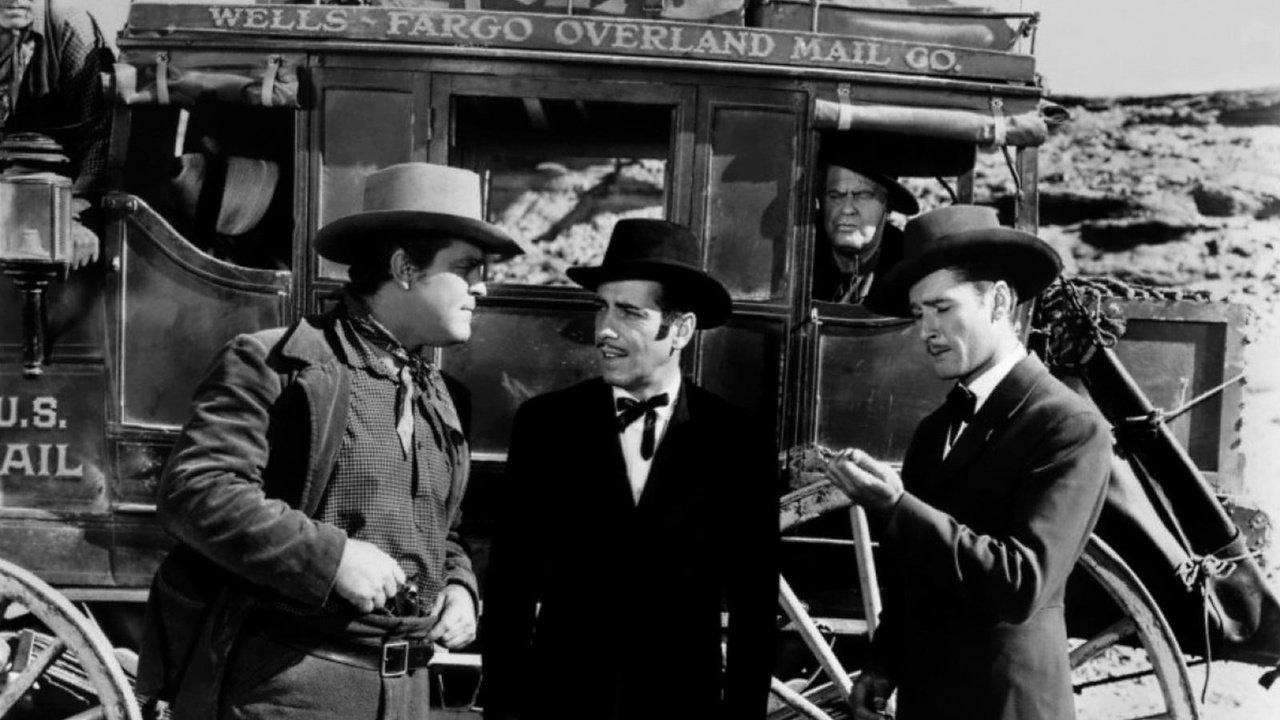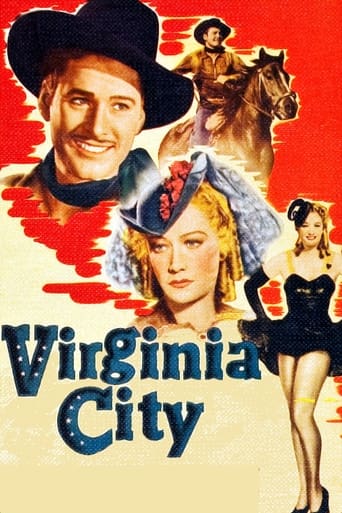

Those who are not used to classic Hollywood productions will probably shun this picture if only because the plot is somewhat complex and there are some glaring mistakes. Nevertheless, the simple fact that Errol Flynn is the lead role makes up for many of the shortcomings and makes this yet another solid production featuring Flynn and director Michael Curtiz.In a story somewhat reminiscent of Gone With the Wind and Flynn's previous film Dodge City, Union captain Bradford (Flynn) escapes with his two sidekicks (the same in Dodge City) and travels to Virginia City to try and stop a group of Southerners from bringing $5 million in gold back from the mines of Nevada in order to fund the war which they are badly losing. This creates for some great tension scenes which I found very provocative between Flynn and Randolph Scott as the leader of the Southerners. Miriam Hopkins plays the role usually reserved for Olivia de Havilland, and although she isn't as personable or warm as her, Hopkins holds her own with both Scott and Flynn.As for Humphrey Bogart as a Mexican bandit, he is highly miscast, but still a solid part of this strong cast that all comes together in the end in a final shootout in the desert. Curtiz certainly knows how to stage action scenes and those here are some of his best. Of course, like most others, this film belongs to Flynn. He is one of the most charismatic and likable leading men ever and his talents are at their best here. He is one of the very few actors who can make a film better simply with his presence. This one is no exception.
... View MoreIn the 1940 film "Virginia City", Errol Flynn stars as a Yankee spy during the Civil War who befriends Miriam Hopkins and her Southern friends while trying to uncover the location of a huge shipment of Confederate gold. It's all done with the usual cast of characters from the Warner Brothers stock company of actors including Alan Hale, Guinn Williams, John Litel etc. and directed by the great Michael Curtiz. Unfortunately, director Curtiz didn't put his usual effort into this film, probably because the script and story were of little interest to him. That said, it's still an above-average movie that certainly has its moments. The climactic battle between the desperate Southerners and their wagon train against a horde of Mexican banditos (led by Humphrey Bogart of all people) is well-staged. Before that happens, the long dreary journey through the desert by the Southerners as they slowly run out of water is quite effective and will jerk a few tears from even the most hardened viewers. "Virginia City" is more than an adequate western by today's standards, but it got somewhat lost in the shuffle back in 1940. As fine an actress as she was, Miriam Hopkins didn't always light the screen on fire. She was better-suited for playing the "other" woman than for being the love interest. Nevertheless, she does fine work in this movie and brings plenty of intelligence to her role. Randolph Scott is Flynn's nemesis in the film but he certainly isn't the "bad guy." That dubious honor falls to Humphrey Bogart. He's the leader of the Mexican bandits, but even with his sleazy mustache still looks like he belongs in downtown Manhattan. Flynn, as always, does what he can with the material and elevates the film with his mere presence and natural abilities. Unlike the real Civil War, it all ends happily in "Virginia City" thanks to good old Abe Lincoln. He pardons everyone before he heads to Ford's Theater.
... View MoreThis is a very good and watchable Warner Brothers Western that COULD have been a lot better if it had been a true sequel to the Flynn film, DODGE CITY. You see, just a year earlier Flynn and his two side-kicks, Alan Hale and Guinn 'Big Boy' Williams, had starred in the marvelous film DODGE CITY. At the very end, the trio (plus Olivia DeHavilland who is strangely absent from this next film) agree at the film's conclusion to leave Dodge City and move to Virginia City to bring the town law and order. Well, here there are again but the plot and characters have been changed so much it really isn't a sequel--even though it was announced as one in the previous film. It really looks like the writers never even saw the other film or read the script, as this time Errol and his buddies are not ex-Confederate soldiers, but Union spies! However, the mood and tempo of the two films are awfully similar. In fact, they are so similar that it is very, very easy to mix them up in your mind. As just one example, both feature a cute little boy in a "dead meat" role. In other words, they are nice kids who ultimately MUST be killed because that is part of the Hollywood formula. Apart from a small age difference, the two boys look almost exactly the same. The films also feature lawless towns and the same fearless trio who arrive to clean it up and do good. And, most of the rest of the actors are identical and play very, very similar parts!So, here is an easy way to distinguish them--DODGE CITY is filmed in gorgeous Technicolor and VIRGINIA CITY features Humphrey Bogart as a swarthy Mexican bandit!!! Oh, and by the way, Bogart as a Mexican actually is a lot worse than it sounds!! When it comes to stupid casting decisions, this SHOULD rank up there with John Wayne as Genghis Khan or Katherine Hepburn as a Chinese woman or Liberace as a handsome leading man torn between his music and his woman, though oddly, the dumbness of this casting has mostly been forgotten over the years. Despite the movie being excellent overall, the few scenes where Bogart speaks are unintentionally hilarious.Now, in addition to Bogart, there is another weakness in the film and that was the casting of Miriam Hopkins as Flynn's love interest. After having seen the immensely beautiful Olivia DeHavilland in the previous film, it really was odd that they would have chosen a woman who just looked old and not particularly attractive. I know this sounds cruel, but I just couldn't see Flynn falling for her. Plus, in DODGE CITY, they fortunately never got DeHavilland to sing but passed that chore on to Ann Sheridan--a woman with a very competent voice. But Miss Hopkins sang her own songs as a bar room chanteuse and sounded pretty awful. So I assumed that the guys in the bar have been pretty drunk to enjoy having her as their host.Now despite all these many complaints, I still gave the movie a score of 7. This is possible due to the always wonderful acting of Flynn in his prime as well as the rest of the cast. Bogart and Hopkins aside, the cast was terrific (McHugh, Hale, Williams and others) and adding Randolph Scott to the mix was a very good thing. Good old fashioned Warner Brothers fun--not to be missed by fans of the genre.
... View MoreIt has been said, "a city on hill cannot hide itself" and Virginia City, Nevada, perched on the side of Mt. Davidson at 6200 ft. west of Tahoe, is a prime example, or in the context of the movie, should be. Virginia City exploded in the American dream as a shower of gold and silver, suspiciously the same year the Civil War began. It was the birthplace of the dean of American letters; it was where a young reporter named Samuel Clemens began using the name "Mark Twain" and went on to become America's most famous writer. It was also the birthplace of the great Hearst fortune, and the launching pad of John Mackay, who became the wealthiest man in America, the third wealthiest man in the world. Hey, they should have made the movie about him! In the 1860's Virginia CIty was THE boomtown of all boomtowns, the home of the big bonanza, at one time the largest "metropolitan" area west of St. Louis and East of San Francisco. But Virginia City (the movie) misses all that and is more about a hogwash North/South duello between the characters played by Errol Flynn and Randolph Scott. Flynn is Capt. Kerry Bradford, a Union officer who is a POW in a concentration camp run by a mean Confederate commander named Capt. Vance Irby, played by Scott. These two are always getting in each other's way. Bradford escapes and then tries to stop a shipment of gold bullion being "snuck" out of VC by who else other than . . . Irby! "Hey, what's he doing here!?" Horrible. Bogart plays a laughable Mexican bandit who can't decide who's side he's on. Miriam Hopkins plays a murky character named "Julia Hayne", obviously a historical lunge at the town's first lady, Julia Bulette, who in real life a celebrated prostitute. She goes to Washington and talks Honest Abe about saving BRADFORD (not Irby) from hanging and blah blah blah. Go figure. They shoulda hung the writer. In "real life" Twain reports that on the last day of the War, the setting sun caused the American flag atop Mt. Davidson to appear to the puzzled residents to be weirdly on fire, kind of like the movie. Three days later they discovered that on that day the South capitulated. One interesting quirk in the film is how sidekicks Alan Hale and Guin Williams flick their pistols forward when they shoot, like they're fishing, or trying to make the bullets go faster. Not a bad idea for the movie. The same kind of goofiness is lathered over sap and corn throughout the movie. Gosh, how could they miss the gold madness, profligate wealth, gun battles in the silver mines, Mark Twain getting run out of town and beat up after a showdown, the crooked railroad, the Opera House fire, Artemis Ward, Bulette's huge funeral, the Chinese tongs, the black saloons, the Auction . . ? All this high on a mountain surrounded by desert? The truth was unreal. Did its fabulous wealth actually spark the great American holocaust? Well, if you count this movie, it wouldn't be the first debacle to come out of Virginia City. It's a disappointment for Virginia City fans because it misses what made the town a "city of illusions," where it is said evil seeps out of the ground . . . Okay, other than that it's a fun movie. Flynn and the gang are always great no matter what history they're destroying. If Flynn would just play his rotten self I'd double my rating.
... View More